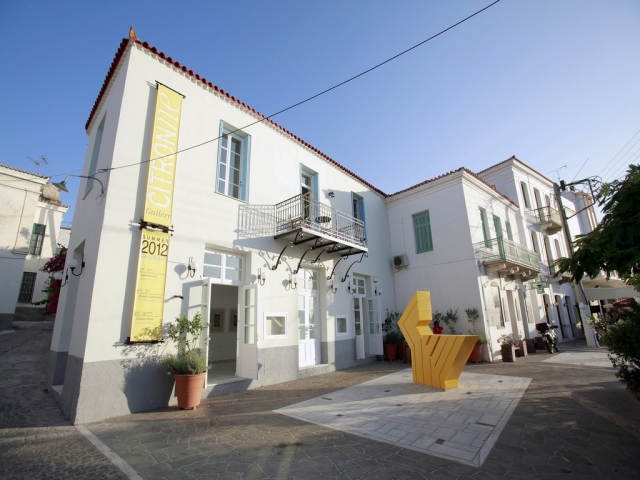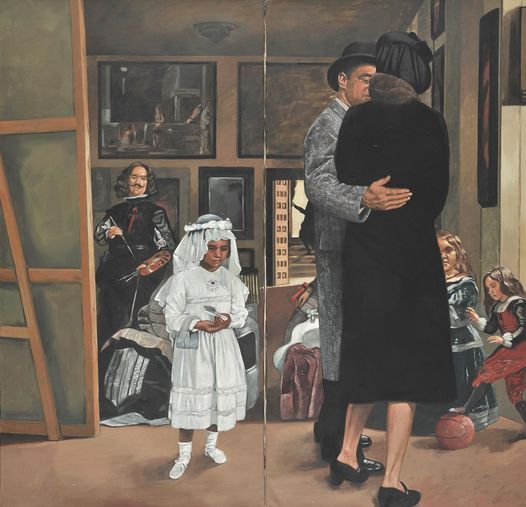Las Meninas
Painting by Kyriakos Katzourakis. 1976
National Gallery, Athens
See more posts like this on Tumblr
#Greece #Pictures #Painting #Katzourakis #National GalleryMore you might like

The exhibition, Kyriakos Katzourakis’ Works 1963-2013: Painting, Theater, Cinematography, will take place in the Benaki Museum on Pireos Street from April 25 to July 28. This retrospective tribute to Katzourakis covers 50 years of creative work, from 1963 to the present day, and aims at shedding light on all aspects of the artist’s creative oeuvre, as well as on his efforts to highlight the links between painting and other arts.

The National Gallery in Athens, Greece, inaugurated a digital exhibition of El Greco attended by Greek President Prokopis Pavlopoulos as well as Attica Region governor Rena Dourou and Alternate Minister for Culture Nikos Xydakis.
The exhibition presents the artist’s monumental works that cannot be transferred as a result of their size, or because they are in temples and religious institutions.
With the help of advanced digital technology, collections are recomposed (shrines, chapels, etc.) whose their works have been scattered in museums and collections around the world.
Introductory video here: https://youtu.be/YtX9T7QMHsE

The exhibition aims to familiarize the public with the seascape in Modern Greek painting. Intimately connected with the life of Greek people, their memories and experiences, the sea has been a source of inspiration for artistic creation since the last quarter of the 19th century.
The exhibition is divided into three sections: The first part of the exhibition comprises works of the great Greek seascape artists Konstantinos Volanakis, Vassileios Chatzis and Ioannis Altamouras. In these paintings, the first influences of Iimpressionism can be identified.
Link to the exhibition here:
http://www.nationalgallery.gr/site/content.php?artid=705
Nikos Lytras (1883 - 1927)
Boat with Sail (Panormos, Tinos), ca 1925
Image source: National Gallery - http://www.nationalgallery.gr/

Greece’s newly refurbished National Gallery-Alexandros Soutsos Museum in Athens is ready to welcome visitors when epidemiological data allows for the opening of all museums, the Greek Culture Ministry said in a statement issued on Friday.
The emblematic works for the expansion and renovation of the building “impressed visitors and spectators on March 24, in the launch of celebrations of the 200th anniversary of the Greek Revolution of 1821,” said the ministry.
When fully open, the public will have the opportunity to see the permanent collection of the National Gallery and works from the interwar period, it added.
Read more here (in Greek): https://longreads.news247.gr/ethniki-pinakothiki/index.html
More than 2,000 years ago, Greek artists created bronze sculptures that are as beautiful and expressive as anything made before or since. And they were prolific, molding tens of thousands of gleaming likenesses of civic leaders, poets, gods and heroes.
Only about 200 remain today, which makes the latest exhibit at the National Gallery of Art all the more odds-defying. One quarter of the survivors are on view as part of “Power and Pathos: Bronze Sculpture of the Hellenistic World,” through March 20.
“We’ve brought together as many large-scale bronze sculptures as have ever been brought together before, and the ones we’ve chosen are of the highest order,” says Jens M. Daehner, an antiquities curator at the J. Paul Getty Museum in LA, who co-curated the exhibit with the Getty’s Kenneth Lapatin. The exhibit arrives in D.C. after stops in Florence, Italy, and Los Angeles.

Born in Athens in 1944, Kyriakos Katzourakis studied painting at the School of Fine Arts as well as in England at St. Martins School of Art. He also studied stage scenery. In 1968, he was awarded the “Parthenis Prize”. He lived in England from 1972 to 1985, where, with the help of Eduardo Paolotsi and Arts Council, he organised an exhibition of his works at the Serpentine Gallery (1976). He has been working permanently in Greece since 1986. He is founder of the group “5 Young Greek Realists.”
In movies, among other things, Katzourakis was scenographer of Pantelis Voulgaris’s “To proxenio tis Annas” and he also created the costumes for “Days of ‘36” by Theodoros Angelopoulos. Besides “Small Revolts”, he also directed the films “The Way to the West” and “Sweet Memory”. His films are currently being shown at the Benaki Museum.
“When I hear the word crisis, I feel the opponent’s futility,” said Kyriakos Katzourakis. “Obviously, capitalism is suffering a crisis of age and admits it openly, but is it sharing it with common people, instead of sharing its capital?” The director and artist, whose latest film Small Revolts (starring Katia Yerou) was recently screened for the first time, perceives the crisis as a word from the new economic vocabulary that obscures ordinary things. “You hear the word 'crisis’ and you are horrified,” he said, “it defeats you and you feel a terrible shock because of your courage to request a pension, salary, education and care. Who will give you these things, when your boss is in a crisis?”
El Greco
Content creation for videowall and projection presentation for the 400 years tribute exhibition of El Greco at the National Gallery of Athens, Greece, 2015.
nationalgallery.gr/site/content.php?artid=742&set_locale=2
Video by Thetis Parmenidou

The exhibition “Windows 1974 - 2013” will be presented at the art gallery Kapatos (12 Athinas Street, Monastiraki underground station). The opening of the exhibition will take place on 11 April and it will run until 24 May 2013.

For nearly a decade, on and off, Andreas Georgiou has been Greece’s Public Enemy No. 1.
The government has brought a relentless series of criminal prosecutions against him. His countrymen have sought their own vengeance by hacking his emails, dragging him into court, even threatening his life. His lawyers in Greece are now preparing for his latest trial, which begins this month; Georgiou himself will watch from the United States, where he lives in a sort of self-imposed exile.
Georgiou is not a mobster. He’s not a hit man or a spy. He’s a statistician. And the sin at the heart of his supposed crimes was publishing correct budget numbers.
For decades, the term “Greek statistics” had been a punchline. Official data were massaged so that the government could claim it was meeting European Union fiscal commitments and retain access to international capital markets. The Greek statistical service, which was controlled by whatever party held power, had taken to reverse-engineering its official budget data. That is, it would choose a final number at the outset and then backfill the assumptions necessary to produce that result. (This technique is not unique to the Greek government, of course.)





